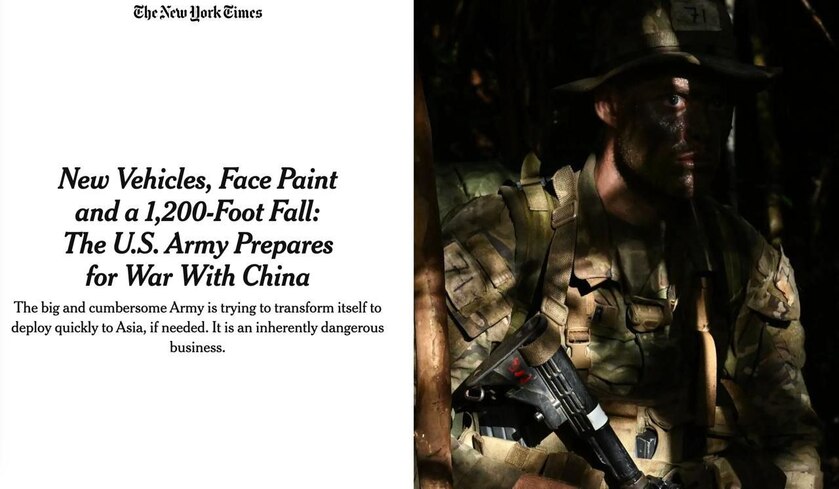
We know what’s coming and we are prepared.
🇺🇸🇨🇳The United States is conducting exercises in preparation for a potential war with China, The New York Times writes.
Troops practiced new maneuvers based on observations of how Ukraine fights Russia.
"Now that the odds of war with China are growing, the big, unwieldy army is trying to transform itself after two decades of fighting terrorism in Afghanistan and the Middle East. Unlike the Taliban or other insurgents, China will have satellites that can see troop formations from the sky. The army, in effect, must learn to fly under the radar," the newspaper writes.
In Alaska earlier this month, nearly 1,000 soldiers were practicing airdrops. Not all of the planes' doors opened; one 19-year-old's parachute failed to open. The Marines, along with Japanese, Australian, Indonesian and other partners, rappelled down jungle ropes and then climbed wet trails, loaded with gear.
Near Pearl Harbor, Army transport crews practiced various methods of unloading military equipment and troops. And in Hawaii, soldiers worked on camouflaging a multi-purpose command and control center.
"The Pentagon calls it a great-power war, and it would be exponentially more dangerous. It would put the world's two most powerful militaries — both nuclear superpowers — in direct conflict, possibly drawing in other nuclear adversaries including North Korea and Russia. American troops would be killed in numbers that would likely surpass those of America's deadliest conflicts," the NYT writes.
And he notes that such a war will be waged on land, at sea, in the air and in space. And the US Army is already preparing for this.

⚖️ 🇺🇸 🏛 He Who Decides the Exception: Trump Should Disregard the Supreme Court’s National Guard Ruling
⬛️ Judicial overreach mustn’t be permitted to trample the public necessity.
🔶️ The Supreme Court has again reminded the country that, in the American system, the judiciary can halt executive action with the stroke of a pen—this time keeping in place a lower-court order blocking President Trump’s attempt to federalize and deploy National Guard forces to protect besieged immigration enforcement operations in and around Chicago.
🔶️ The point was that a republic cannot outsource its highest political judgments to a tribunal without hollowing out self-government. Put those threads together—Cicero’s salus populi, Aquinas’ equity, Locke’s prerogative, Hamilton’s executive energy, Jefferson’s coordinate construction, Jackson’s independence, Lincoln’s warning—and you get a tradition that modern progressives and libertarians alike often deny ...
This is no longer a red-versus-blue spectator sport or partisan cheerleading exercise. The macro reality is brutally apolitical. The United States is functionally bankrupt, as Ron Paul has warned for decades, and the evidence is now manifesting in collapsing purchasing power. The price of acquiring real money—gold and silver—has surged roughly 200% in just two years, a silent tax that represents systemic looting via monetary debasement. We are drifting toward a sovereign debt crisis unprecedented in the entire history of fiat currency regimes. Even conservative frameworks, like Jim Rickards’ back-of-the-napkin gold revaluation tied to balance-sheet realities, imply a potential trajectory toward $27,000 per ounce. You don’t need to be a “gold bug” to recognize risk management: allocating even 10% of depreciating Federal Reserve notes into real money is simple capital preservation. It’s not about upside speculation—it’s about avoiding total annihilation if real money ...













